Electric Vehicle Market by Component, Vehicle Type, Vehicle Class, Propulsion (BEV, PHEV, FCEV), Vehicle Drive Type (FWD, RWD, AWD), Vehicle Top Speed (<125 mph, >125 mph), Charging Point Type, Vehicle Connectivity, End Use, Region - Global Forecast 2030
[357 Pages Report] The global electric vehicle market size was valued at USD 388.1 billion in 2023 and is expected to reach USD 951.9 billion by 2030 at a CAGR of 13.7% during the forecast period 2023-2030. With advancements in technology, increasing environmental consciousness, and supportive government policies, EVs have gained significant traction as a viable and sustainable transportation option. As concerns over climate change and air pollution intensify, consumers and industries are increasingly turning to electric vehicles to reduce their carbon footprint and contribute to a greener future. This growing global momentum has propelled the electric vehicle market into a transformative phase, with innovations and investments driving the expansion of EV adoption across the world.
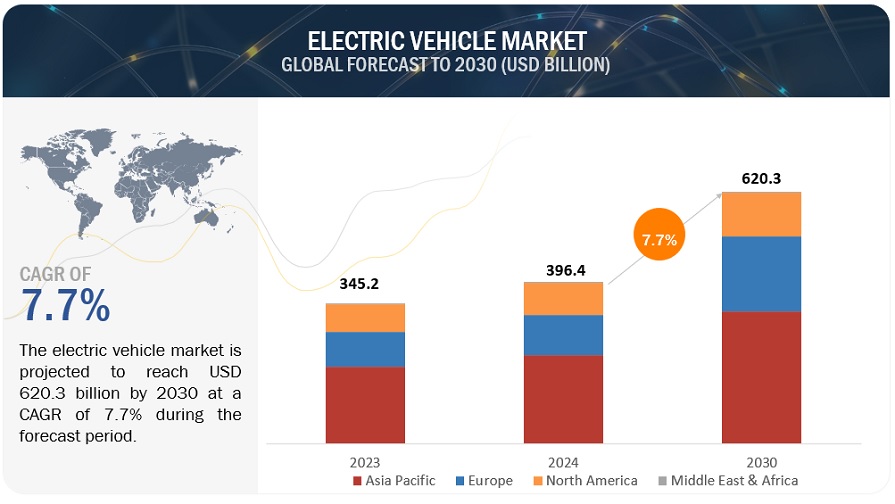
To know about the assumptions considered for the study, Request for Free Sample Report
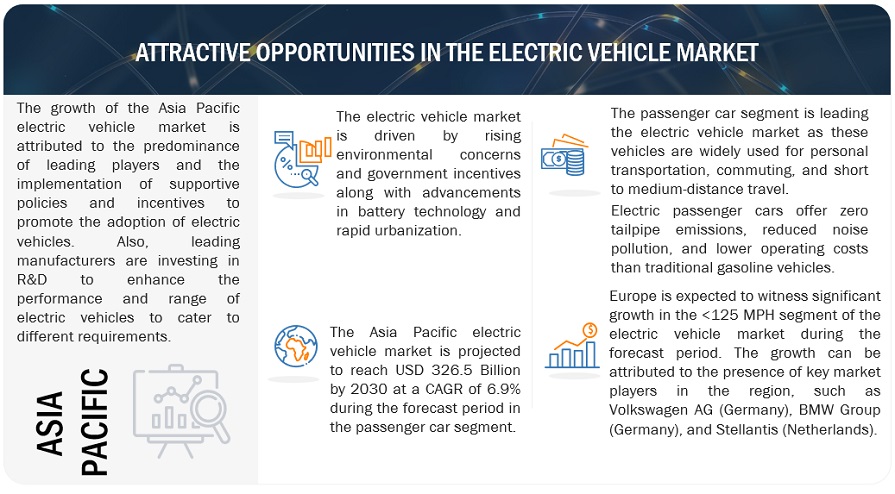
To know about the assumptions considered for the study, download the pdf brochure
Electric Vehicle Market Growth Dynamics:
Driver: Reducing prices of EV batteries will increase demand for EVs by making them cost effective
Due to technological advancements and the production of EV batteries on a mass scale in large volumes, the cost of EV batteries has been decreasing during the past decade. This has led to a decrease in the cost of electric vehicles as EV batteries are one of the most expensive components of an electric vehicle. The prices of EV batteries fell significantly in the last decade, from USD 1,200/kWh in 2010 to USD 160/kWh in 2023 and is expected to decrease in the coming years. Meanwhile the price is as low as USD 100 per kWh in China. This is because of the reducing manufacturing costs of these batteries, reduced cathode material prices, higher production, etc. The prices of EV batteries are expected to fall to approximately USD 60 per kWh by 2030, which is expected to significantly reduce the prices of EVs, making them cheaper than conventional ICE vehicles. The price of EV batteries is expected to reach around USD 80 per kWh by 2025. This will bring the price of EVs to the same level as that of ICE vehicles in the market and start a big shift to EVs. From 2025, we can expect EVs to get cheaper than some ICE vehicles. The improvement in battery technology is the main reason for this fall in battery prices. Once Solid-State Batteries enter the electric vehicle market, we can expect another price fall (per kWh) by the end of this decade.
Restraint: High initial investments for installing EV fast charging infrastructure
The initial investment in setting up a fast-charging system is significantly higher compared to petrol, CNG, or LPG fuel stations. This has been a major restraint for countries around the world in adopting EVs on a higher scale during the past decade. Technological enhancements are expected to negate this restraint, leading to decreasing costs. The cost for EV fast charging is high due to the higher equipment costs and the requirement for an additional fast charger to install a transformer to connect the grid and charging system. This has led to the slower development of charging networks around the world which have gained traction during the past few years due to vehicle emission concerns. The high initial investment required for EV infrastructure is one of the key factors influencing EV sales. Setting up a comprehensive and efficient EV charging station can incur significant costs. For instance, in India, a single DC fast charger setup could cost more than USD 12,193, and if multiple chargers are installed, the initial investment could easily go up to USD 48,772, taking into account the cost/rent of the land. The type of chargers installed also impacts the investment, with different charger types having varying costs. In APAC region for instance prices vary by charger type and have additional costs. These include additional expenses such as that for obtaining a new electricity connection, civil works, EVSE management software and integration (approximately USD 9,145), and technicians, manpower, and maintenance (around USD 4,267 yearly). Advertising and promotion costs (about USD 609) and land lease expenses (around USD 7,316 yearly if the land is leased) further add to the total. Consequently, the total approximate cost for the first year, including setup and leased land, could reach USD 487,72. Subsequent operational costs, starting from the second year, amount to USD 12,193 annually, including land lease expenses. Operational costs include software maintenance, technical maintenance, and manpower expenses, all contributing to the significant investment required for establishing and running an EV charging station. These high initial and operational costs create barriers for businesses and individuals looking to invest in EV infrastructure, which in turn can impact the growth and adoption of EVs in the market. Nevertheless, as the demand for EVs rises and technology improves, we can expect to see potential reductions in these costs over time.
Opportunity: Rising demand for electric vehicles in the automotive and transportation sectors
Increase in the adoption and demand for electric vehicles has accentuated the need to develop charging infrastructure and the electric vehicle market. Leading markets for electric vehicles such as China, US, and Germany are investing significantly in electric vehicles and EV charging infrastructure along with research & development for faster and efficient charging methods, longer range EVs, and lower cost batteries. Significant investments by automakers are expected to cater to the rising demand for EVs. Countries across North America and Europe along with many Asian countries have adopted measures to reduce emissions during the coming decades and replace their vehicle fleets for lower emissions by varying numbers by 2035. This is expected to lead to a significantly high demand for electric vehicles. OEMs offer a wide range of vehicles, from small hatchbacks such as Leaf to high-end sedans such as Tesla model 3. The wide range of product offerings has attracted a high number of consumers, resulting in an increased market for electric vehicles. For instance, in January 2018, Ford announced plans to increase planned investments to USD 11 billion by end of 2022 for the development of EVs. The company introduced 40 EVs in 2022, of which 16 are expected to be fully electric and 24 are expected to be plug-in hybrid vehicles. The investment is higher than the previously announced target of USD 4.5 billion. Further, Stellantis also plans to come with 29 new EVs by 2030. Launched in September 2020, SAIC-GM-Wuling has a range of 106 miles on a single charge and was one of the highest selling EVs in 2021 and 2022.
Challenge: High cost of electric vehicles (compared to ICE)
The high manufacturing cost of EVs has been a major concern in their widespread adoption. The expected reduction in battery prices and reduced R&D costs are expected to lead to the reduction in the overall cost of purchasing electric hatchbacks, crossovers, or SUVs to reach the levels of ICE vehicles, leading to the rising demand for EVs. The cost of EVs is significantly high compared to that of ICE vehicles due to the high price of rechargeable lithium ion batteries required for these vehicles. The price of the cathode affects the price of the batteries to a high extent. This is because materials such as cobalt, nickel, lithium, and magnesium used in these batteries is high-priced. The cost of the production of EVs is also significantly high compared to ICE vehicles due to the expensive process involved in developing these vehicles. The cost of the development of higher range EVs is significantly higher due to the requirement of higher specification batteries, advanced technology used for production, and highly expensive components used in the vehicles.
Market Ecosystem

FCEVs to be the fastest growing segment during forecast period
The FCEV uses fuel cells to generate electricity for powering the vehicle. Fuel cells in a vehicle generate electricity from the oxygen in the air and compressed hydrogen. FCEVs are completely emission-free as they emit water or heat. FCEVs have been introduced in the US, majorly in California. Many renowned truck manufacturers have already developed fuel-cell electric trucks. For instance, in September 2022, Toyota Motor Corporation (Japan) and Kenworth (US) designed heavy-duty Class 8 FCEVs. Similarly, in January 2023, Adani Group (India) signed an agreement with Ashok Leyland (India) and Ballard Power (Canada) to launch a pilot project for a hydrogen fuel cell electric truck in India Japan and Europe are focusing on the launch of FCEVs. Top FCEVs on the road that are commercially available include Hyundai Tucson FCEV, Toyota Mirai, Hyundai Nexo, and Honda Clarity. Fuel cell vehicles have higher fuel economy and can travel approximately 300–400 miles with a full fuel tank. The best FCEVs can have a range of more than 500 miles on a single filling. The refueling time for fuel cell-powered vehicles is approximately three to five minutes. This makes FCEVs an ideal option for transportation on definite or fixed routes. However, the availability of infrastructure such as hydrogen refueling stations and hydrogen production facilities supporting fuel cell technology is very limited worldwide due to the high cost of the fuel cell stack and system. Hydrogen is also difficult to store and transport which adds to the cost of the system. However, governments of various regions are increasingly investing in the development of hydrogen-powered vehicles and hydrogen infrastructure. For instance, in November 2022, the Government of Alberta in Canada announced an investment of USD 300 million from the Strategic Innovation Fund's Net Zero Accelerator initiative, along with a provincial contribution of USD 161.5 million, to back a substantial USD 1.6 billion project led by Air Products Canada Ltd. The project aims to drive the advancement of clean fuels and clean energy in Canada while creating numerous middle-class job opportunities. The funding will specifically support the construction of a hydrogen production and liquefaction facility in Edmonton. The facility will utilize auto thermal reforming and carbon capture technology, further emphasizing the commitment to sustainable and environmentally friendly solutions.
Mid-priced EV segment to be the largest market during the forecast period
A mid-priced vehicle is considered to have a price of USD 30,000 to USD 45,000. This vehicle class has limited features with low emphasis on features such as infotainment, instrument cluster, and other expensive features. China is one of the leading markets for the mid-priced segment. Established automotive manufactures such as Hyundai, General Motors, Honda, and Nissan are also manufacturing mid-priced EVs to acquire higher market shares. Some other mid-priced EVs include BMW 3 Series PHEV, Zeekr One, Ford Mustang Mach-E, Volvo XC40, Renault Megane EV, Hyundai Ioniq 5, Volkswagen ID 4, Kia Niro EV, etc. In 2022, BYD Song Pro/Plus was the best selling mid-priced EV in Asia Pacific region, followed by Tesla Model 3 in Europe and North America. The electric vehicle market forecast for the mid-priced segment is the largest in the Asia Pacific and European regions due to the demand for low-emission vehicles at reasonable prices. Various top EV models such as Nissan Leaf, Renault Zoe, Mitsubishi Outlander, Volkswagen Passat, Hyundai Kona, etc. fall under this category. These were also some of the largest selling EVs in these regions excluding Tesla in 2022. Thus, the demand for mid-priced EVs has been high in the past few years and is expected to keep rising in the coming decade. The market in the MEA is expected to grow at the highest rate in this segment as there is expected to be rising new demand in this region for these vehicles in the next decade.
Asia Pacific to be the largest and the fastest growing market by value during the forecast period
The region is home to some of the fastest-developing economies, such as China and India. The governments of these emerging economies have recognized the growth potential of the electric vehicle market trends and, hence, have taken different initiatives to attract major OEMs to manufacture electric vehicles in domestic markets. The region is home to 93 of the world’s most polluted cities, and has a high energy demand. As of 2022, transportation sector in the region accounts for around 14% of overall emissions. Thus, countries in the region, are planning to reduce emissions in the coming years. China, the e-mobility leader in the region, had set a target of over 20% EV sales by 2025, which it had already achieved in 2022 and is expected to have around 35% in 2023. Similarly, countries such as South Korea, Japan and India have also announced plans to shift to EVs in coming years. India for instance, plans to have 30% of its passenger car sales to be electric by 2030. South Korea and Japan are also aiming to be among the world’s top 5 EV producers by 2030. China is also investing significantly in the production of both electric passenger as well as commercial vehicles, with plans for export. OEMs such as BYD plan to open plants in other parts of the world to manufacture electric buses and electric trucks to meet regional demand. The country supports EV usage by offering a subsidy for buying EVs. The country is also encouraging manufacturers to develop better EV technology. Various EV charging stations are set up across the country due to the subsidy for setting up EV infrastructure. The country has promoted the development and use of EV buses and trucks. In 2020, a low-cost EV passenger car, Wulin Hongguang Mini EV, was developed in China, costing less than USD 5,000. The vehicle sold majorly in the domestic market, but its gross sales were the second highest of the total EV sales in 2022. The demand of Mini-EVs has been growing in the country, with more choices available with other leading Chinese manufacturers entering the mini-EV space. Luxury EVs have also increased in demand in the country, with major domestic OEMs in China have grabbed the market share. According to various official estimates, the market share is expected to be around 35% of the total vehicle market in 2023.
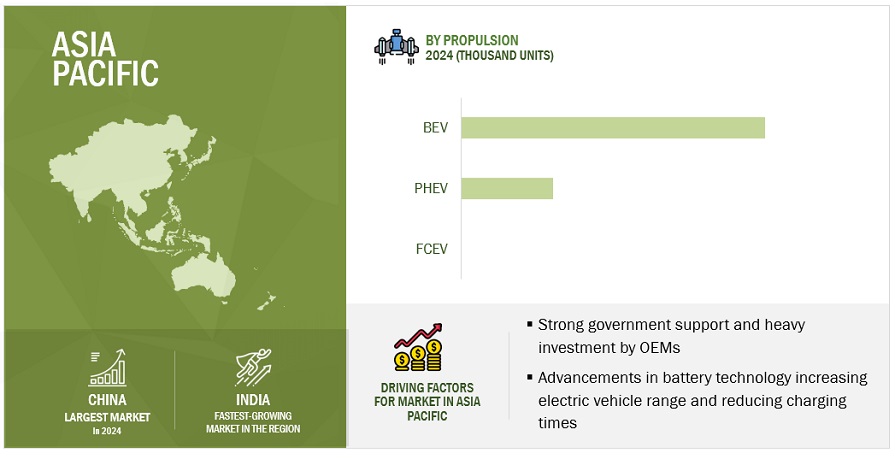
Key Market Players
The electric vehicle market is dominated by BYD (China), Tesla (US), Volkswagen AG (Germany), SAIC Motors (China), and Stellantis (Netherlands), among others. These companies have worked with other players in the EV ecosystem and developed best in class EV technology.
Get online access to the report on the World's First Market Intelligence Cloud
- Easy to Download Historical Data & Forecast Numbers
- Company Analysis Dashboard for high growth potential opportunities
- Research Analyst Access for customization & queries
- Competitor Analysis with Interactive dashboard
- Latest News, Updates & Trend analysis
Request Sample Scope of the Report
Get online access to the report on the World's First Market Intelligence Cloud
- Easy to Download Historical Data & Forecast Numbers
- Company Analysis Dashboard for high growth potential opportunities
- Research Analyst Access for customization & queries
- Competitor Analysis with Interactive dashboard
- Latest News, Updates & Trend analysis
|
Report Metric |
Details |
|
Market Revenue in 2023 |
USD 388.1 billion |
|
Estimated Value by 2030 |
USD 951.9 billion |
|
Growth Rate |
Poised to grow at a CAGR of 13.7% |
|
Market Segmentation |
Components, Vehicle Type, Vehicle Class, Top Speed, Vehicle Drive Type, EV Charging Point Type, Vehicle Connectivity, End Use, Propulsion and Region. |
|
Market Driver |
Reducing prices of EV batteries will increase demand for EVs by making them cost effective |
|
Market Opportunity |
Rising demand for electric vehicles in the automotive and transportation sectors |
|
Geographies covered |
Asia Pacific, Europe, North America, Middle East & Africa |
This research report categorizes the electric vehicle market based on Components, Vehicle Type, Vehicle Class, Top Speed, Vehicle Drive Type, EV Charging Point Type, Vehicle Connectivity, End Use, Propulsion and Region.
Based on Components:
- Battery Cells & Packs
- On-Board Charge
- Motor
- Reducer
- Fuel Stack
- Power Control Unit
- Battery Management System
- Fuel Processor
- Power Conditioner
- Air Compressor
- Humidifier
Based on Vehicle Type:
- Passenger Cars
- Commercial Vehicles
Based on Vehicle Class:
- Low-priced
- Mid-priced
- Luxury
Based on Top Speed:
- <125 MPH
- >125 MPH
Based on Vehicle Drive Type:
- Front Wheel Drive
- Rear Wheel Drive
- All Wheel Drive
Based on EV Charging Point Type:
- Normal Charging
- Super Charging
Based on Vehicle Connectivity:
- V2B or V2H
- V2G
- V2V
- V2X
Based on Propulsion:
- BEV
- PHEV
- FCEV
Based on End Use:
- Private
- Commercial Fleets
Based on the region:
-
Asia Pacific
- China
- India
- Japan
- South Korea
- Thailand
- Indonesia
- Malaysia
- Vietnam
-
North America
- US
- Canada
-
Europe
- France
- Germany
- UK
- Netherlands
- Switzerland
- Austria
- Norway
- Spain
- Denmark
- Sweden
Recent Developments
- In June 2023, PowerCo, a subsidiary of Volkswagen Group, has partnered with Koenig & Bauer to develop a revolutionary technology for battery cell production. The collaboration aims to create a roller press for powder coating electrodes on a large industrial scale, eliminating the need for wet-coating and subsequent drying processes. This Dry Coating procedure significantly reduces energy consumption and eliminates the use of chemical solvents. PowerCo is currently testing and optimizing the technology in a pilot line in Northern Germany. The new procedure has the potential to save approximately 30% of energy and 15% of floor space, and the use of chemical solvents.
- In June 2023, Stellantis and Foxconn have announced the establishment of a joint venture called SiliconAuto. The 50/50 partnership aims to design and sell advanced semiconductors for the automotive industry, including Stellantis, starting in 2026. By combining Foxconn's expertise in the ICT industry with Stellantis' deep understanding of global mobility needs, SiliconAuto will provide a dedicated source of semiconductors for computer-controlled features and modules
- In May 2023, BYD and Toyota have formed a strategic partnership to collaborate on the production and sale of electric vehicles (EVs). Toyota aims to leverage the expertise of the well-established local company, BYD, and benefit from their advanced battery technology in this joint venture.
- In April 2023, Tesla has announced its plan to potentially partner with CATL, a prominent battery manufacturer in China, to establish a US-based factory to comply with the Inflation Reduction Act set forth by the Biden administration. The specific location of the factory is yet to be confirmed, but Texas or California are strong contenders due to their proximity to Tesla's assembly lines.
- In April 2023, Volkswagen has announced a partnership with Shell Germany to expand the charging infrastructure for electric mobility. The collaboration has resulted in the installation of the first 150 kW Elli Flexpole charging station at a Shell service station in Göttingen on May 4, 2023. This innovative charging station, developed by Volkswagen's brand Elli, features a unique battery storage system that allows it to connect to a low-voltage grid. This technology enables easy and flexible installation of charging stations while accelerating grid expansion. Following a successful test operation
- In January 2023, BMW Group and Solid Power have entered into a partnership for the next phase of their joint research and development efforts towards the adoption of solid-state batteries (ASSB) in series production vehicles. As part of an expanded Joint Development Agreement, BMW will establish an ASSB prototype line at its Cell Manufacturing Competence Center (CMCC) in Munich. This collaboration aims to enhance the design and manufacturing capabilities of all-solid-state batteries, with both companies conducting complementary cell development and manufacturing activities.
Frequently Asked Questions (FAQ):
What is the current size of the EV market by volume?
The current size of the EV market is estimated at 12,796 thousand units by volume in 2023.
Who are the winners in the EV market?
The EV market is dominated by BYD (China), Tesla (US), Volkswagen AG (Germany), SAIC Motors (China), and Stellantis (Netherlands), among others.
Which region will have the fastest-growing market for EV market?
Middle East & Africa will be the fastest-growing region in the EV market due to the increasing awareness of environmental sustainability, supportive government initiatives, and advancements in charging infrastructure.
What are the key technologies affecting the EV market?
The key technologies affecting the EV market are the battery technology, electric motors and drivetrains, vehicle-to-grid (V2G) technology, autonomous driving, solid-state batteries, among others.
To speak to our analyst for a discussion on the above findings, click Speak to Analyst
5 MARKET OVERVIEW (Page No. - 58)
The study involved four major activities in estimating the current size of the electric vehicle market. Exhaustive secondary research was done to collect information on the market, the peer market, and the child markets. The next step was to validate these findings, assumptions, and sizing with the industry experts across value chains through primary research. The top-down and bottom-up approaches were employed to estimate the complete market size. Thereafter, market breakdown and data triangulation processes were used to estimate the market size of segments and subsegments.
Secondary Research
In the secondary research process, various secondary sources such as company annual reports/presentations, press releases, industry association publications [for example, publications of electric vehicle manufacturers, International Energy Agency (IEA), Alternative Fuel Data Center (AFDC), European Alternate Fuels Observatory (EAFO), Federal Transit Administration (FTA), Regional Transportation Authority (RTA), country-level vehicle associations and trade organizations, and the US Department of Transportation (DOT)], EV related magazine articles, directories, technical handbooks, World Economic Outlook, trade websites, government organizations websites, and technical articles have been used to identify and collect information useful for an extensive commercial study of the global EV Market.
Primary Research
Extensive primary research has been conducted after acquiring an understanding of this market scenario through secondary research. Several primary interviews have been conducted with market experts from the demand- and supply-side OEMs (in terms of component supply, country-level government associations, and trade associations) and component manufacturers across four major regions, namely, Asia Pacific, Europe, North America, Middle East & Africa. Approximately 23% and 77% of primary interviews have been conducted from the demand and supply side, respectively. Primary data has been collected through questionnaires, emails, LinkedIn, and telephonic interviews. In the canvassing of primaries, we have strived to cover various departments within organizations, such as sales, operations, and administration, to provide a holistic viewpoint in our electric vehicle market report.
After interacting with industry experts, we conducted brief sessions with highly experienced independent consultants to reinforce the findings from our primaries. This, along with the in-house subject matter experts’ opinions, has led us to the findings as described in the remainder of this report. Following is the breakdown of primary respondents.
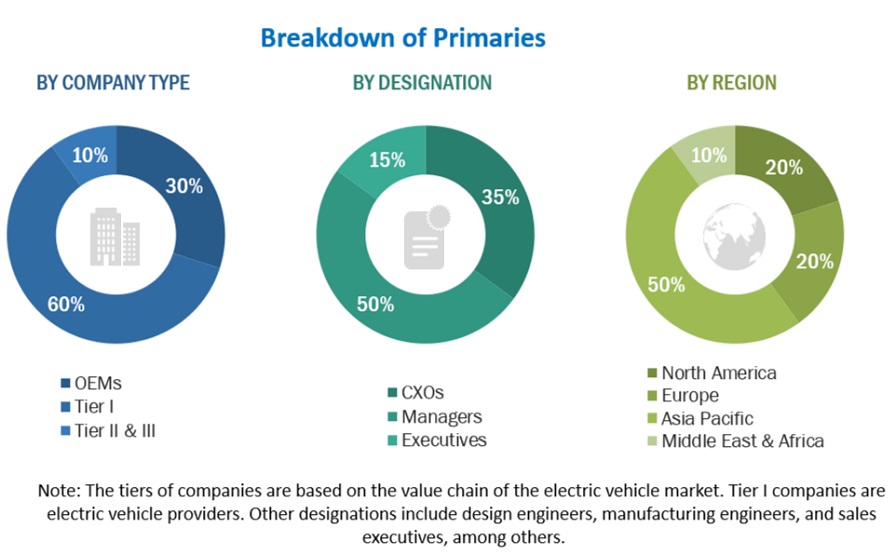
To know about the assumptions considered for the study, download the pdf brochure
Market Size Estimation
The bottom-up approach was used to estimate and validate the total market size. This method was also used extensively to estimate the size of various subsegments in the market. The research methodology used to estimate the market size includes the following:
- The key players in the industry and markets have been identified through extensive secondary research
- The industry’s supply chain and market size, in terms of volume, have been determined through primary and secondary research processes
- All percentage shares, splits, and breakdowns have been determined using secondary sources and verified through primary sources
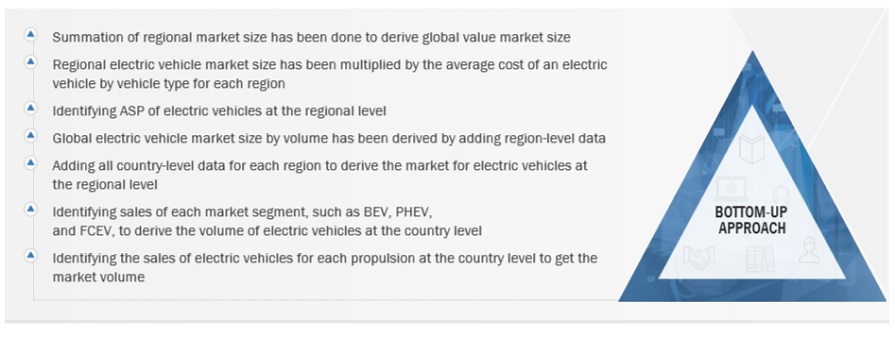
To know about the assumptions considered for the study, Request for Free Sample Report
Market Size Validation
The top-down approach has been used to estimate and validate the size of the electric vehicle market by drive type and top speed in terms of volume.
The top-down approach has been used to estimate and validate the size of the EV Market. In this approach, key drive and top speeds of electric vehicles are identified for each propulsion type (BEV, PHEV, and FCEV) at the country-level. The penetration of each identified drive type and top speed type for each propulsion type is multiplied with the volume of each vehicle at the country-level to derive the total volume. All country-level data is summed up to derive the global market by drive and top speed type.

Data Triangulation
After arriving at the overall market size—using the market size estimation processes as explained above—the market was split into several segments and subsegments. To complete the overall market engineering process and arrive at the exact statistics of each market segment and subsegment, data triangulation, and market breakdown procedures were employed, wherever applicable. The data was triangulated by studying various factors and trends from both the demand and supply sides.
Market Definition
An electric vehicle is an automobile propelled by one or more electric motors. An electric vehicle uses energy stored in rechargeable batteries, which can be charged using private or public charging infrastructure. There are four major types of electric vehicles, namely, battery electric vehicles (BEV), plug-in hybrid electric vehicles (PHEV), hybrid electric vehicles (HEV), and fuel cell electric vehicles (FCEV).
List of Key Stakeholders
- Associations, Forums, and Alliances Related to Electric Vehicles
- Automobile Manufacturers
- Battery Distributors
- Battery Manufacturers
- Charging Infrastructure Providers
- Charging Services Providers
- EV Charging Station Service Providers
- EV Component Manufacturers
- EV Distributors and Retailers
- EV Manufacturers
- Government Agencies and Policymakers
Report Objectives
- To segment and forecast the electric vehicle market size in terms of volume (thousand units)
- To define, describe, and forecast the market based on charging point type, propulsion type, vehicle type, vehicle class, vehicle top speed, vehicle drive type, component, vehicle connectivity, end use, and region
- To segment the market and forecast its size, by volume, based on region (Asia Pacific, Europe, North America, Middle East & Africa)
- To segment and forecast the market based on charging point type [AC (normal charging) and DC (super charging)]
- To segment and forecast the market based on propulsion type [(Plug-in Hybrid Electric Vehicle (PHEV), Fuel Cell Electric Vehicle (FCEV), and Battery Electric Vehicle (BEV)]
- To segment and forecast the market based on vehicle type (passenger cars and commercial vehicles)
- To segment and forecast the market based on vehicle class (low-priced, mid-priced, and luxury)
- To segment and forecast the market based on vehicle top speed (<125 mph and >125 mph)
- To segment and forecast the market based on vehicle drive type (front wheel drive, rear wheel drive, and all wheel drive)
- To segment and provide qualitative insights into the market based on vehicle connectivity (V2B or V2I, V2G, V2V, V2X)
- To segment and forecast the market based on end use (private, commercial fleets)
- To analyze the technological developments impacting the EV Market
- To analyze opportunities for stakeholders and the competitive landscape for market leaders
- To strategically profile key players and comprehensively analyze their market shares and core competencies
- To provide detailed information regarding the major factors influencing the market growth (drivers, challenges, restraints, and opportunities)
- To strategically analyze markets with respect to individual growth trends, future prospects, and contribution to the total market
- To strategically profile key players and comprehensively analyze their market shares and core competencies
- To track and analyze competitive developments such as deals, new product developments, and other activities carried out by key industry participants
Available Customizations
With the given market data, MarketsandMarkets offers customizations in line with company-specific needs.
- Further breakdown of the electric vehicle market, by vehicle drive type at country-level (For countries present in the report)
- Additional countries (apart from those already considered in report) with significant EV Market
Company Information
- Profiles of additional market players (up to five)


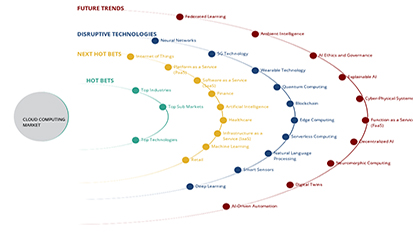

 Generating Response ...
Generating Response ...









Growth opportunities and latent adjacency in Electric Vehicle Market
We want to know the competitive scenario for Electric Vehicle Market? and the Top vendors in the EV Market for the Forecast period 2022 to 2030.
For the Asia market, we have provided the latest industry trends from both supply-side and demand-side, market insights for ASIA at the total and country-level (China, India, Japan and South Korea), and quantified the market size in units and revenues and growth forecast to 2030.
Electric Vehicle Market report also includes the latest industry trends from both supply-side and demand-side, market insights for ASIA market at the total and country-level (China, India, Japan and South Korea) data as well, and quantified the market size in units and revenues and growth forecast to 2030.